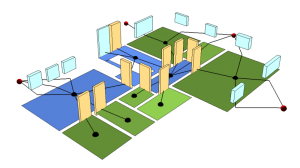Use Case
 Buildings of all kinds regularly need to be refurbished or even rebuilt. Nowadays, 3D models of the buildings and their components play an important role in the planning process. The availability of information about objects to be refurbished ranges from a complete lack of usable information to well-documented, full featured Building Information Models.
Buildings of all kinds regularly need to be refurbished or even rebuilt. Nowadays, 3D models of the buildings and their components play an important role in the planning process. The availability of information about objects to be refurbished ranges from a complete lack of usable information to well-documented, full featured Building Information Models.
Geometric enrichment of existing 3D models
 A common situation in building and planning practice is that the intended and documented state of the building (“as-planned”) differs significantly from the state that is found in physical reality (“as-built”). A number of reasons for such differences exist, such as: the contractor has made changes to the building during the construction or modifications of the as-planned state have been executed without according updates to the existing 3D models.
A common situation in building and planning practice is that the intended and documented state of the building (“as-planned”) differs significantly from the state that is found in physical reality (“as-built”). A number of reasons for such differences exist, such as: the contractor has made changes to the building during the construction or modifications of the as-planned state have been executed without according updates to the existing 3D models.
Processes to assess any deviations between the as-planned and the as-built states of a building are a valuable asset in refurbish or restoration tasks, where up-to-date and comprehensive information about an object is required. One way to achieve this is to enrich existing models with as-built information.
Semantic enrichment
Existing legacy documentation of buildings, such as 2D drawings or 3D models often do not contain the amount and quality of information desirable for building tasks. Such information includes e.g., detailed material properties, vendor information of technical equipment or provenance data. Additionally, much information is implicit and can only be interpreted by human consumers. However, in many preservation and usage scenarios this information needs to be explicit. Explicit information may allow for automation processes, such as searching in large archives for specific architectural styles, for building components in use or for the function of individual spaces. To augment building models unambiguously with additional information, they must be enriched in semantically meaningful ways which are interpretable by both human end-users and processing tools. The sustainability of semantic enrichment shall be supported through interoperability, i.e. self-documenting and vendor-independent semantic enrichment processes in order to be reproducible by arbitrary software tools in the future.
Reuse of existing 3D models
In some cases where an object is to be refurbished 3D models of the specific building might exist – but not be usable due to proprietary file formats. Different architecture and engineering companies may use different software systems and the compatibility between CAD systems is known to be poor. Another technological problems may be the lacking support for an older file format by modern software, also known as file format obsolescence. These examples show the need for preservation of 3D models in such a way that they can easily be re-used by a range of modern software.

